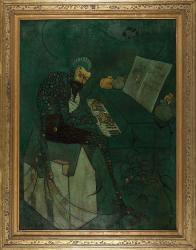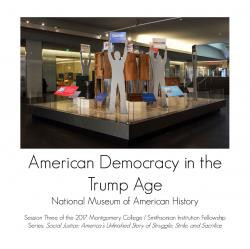Tess Porter
User Experience Strategist (she/her)
Smithsonian Office of Educational Technology
I'm the former User Experience Strategist at the Smithsonian Office of Educational Technology. Here, I focused on the use of digital museum resources to support teaching and learning. My work draws on my experience as a museum educator, digital analyst, usability researcher, and content designer. I hold a B.A. in Anthropology and a B.A. in Art History from University Colorado Boulder, and an M.S. in Museums and Digital Culture with an Advanced Certificate in User Experience from Pratt Institute.
Tess Porter's collections
Flashcard Activity: Conflict, Identity, and Place in American Art
<p>This collection contains a selection of artworks related to the themes of conflict, identity, and place. They may be used for a variety of purposes; here, we use them as a catalyst for discussion. In small groups or as a classroom, have students select one artwork they find meaningful or interesting and discuss the following:</p>
<ol><li>Why did you pick this artwork? </li><li>What do you see? Name specific aspects of the artwork you notice.</li><li>What do you think about what you see?</li><li>What does this artwork make you wonder? </li><li><em>Optional</em>: How might the artwork connect to the themes of conflict, identity, and place?</li></ol>
<p>
</p>
<p>This activity works equally well online or using printed flashcards (see <a href="https://learninglab.si.edu/collections/flashcard-activity-conflict-identity-and-place-in-american-art/wCjeBXbgRgExR2Py#r/883001">the resource tile</a>). You may also replace or pair the above activity with a Project Zero Thinking Routine found in the final section of the collection. </p>
<p><em>This Smithsonian Learning Lab collection contains artwork selected by <a href="https://learninglab.si.edu/profile/666">Phoebe Hillemann</a>, Teacher Institutes Educator at the Smithsonian American Art Museum, to be featured in the 2018 Smithsonian American Art Museum Summer Institute for Teachers, "Teaching the Humanities through Art." The activity is adapted from Project Zero's See / Think / Wonder routine.</em></p>
<p>Keywords: printable, flash card, project zero visible thinking routine, New Jersey Principals and Supervisors Association, NJPSA, saam</p>
 Tess Porter
Tess Porter
51
Pittsburgh & Place
<p>Includes iconic people, places, and things associated with Pittsburgh. In the classroom, these resources can be used by students to investigate two essential questions: How do you define Pittsburgh as a place? What does it mean to be a Pittsburgher? </p>
<p>Supporting questions and activity implementation ideas can be found by clicking the Information (i) button in the upper right. </p>
<p>Keywords: Pennsylvania </p>
 Tess Porter
Tess Porter
44
Ancient Greek Myth: Reinterpreted by African American Artists
<p>In this student activity, analyze the timelessness of myth through three works of art by modern African American artists. Each artist, inspired by Ancient Greek myth, retells stories and reinterprets symbols to explore personal and universal themes. Includes three works of art, summaries of the myths they reference, and discussion questions. Also includes a video about the artist Romare Bearden and his series 'Black Odyssey,' which details Bearden's artistic process, the significance of storytelling in his art, and the lasting importance of 'Black Odyssey.'</p>
<p>Big Ideas: How does myth reflect the values of an individual or their culture? How do myths reflect the human experience? How do myths transcend time and place?</p>
<p>Inspired by a Smithsonian American Art Museum lesson plan, located <a href="https://americanart.si.edu/education/k-12/resources/african-american">here</a>.</p>
<p>Keywords: greece, alma thomas, bob thompson</p>
 Tess Porter
Tess Porter
6
Achelous and Hercules: What makes you say that?
<p>Using the Project Zero Visible Thinking routine "What makes you say that?," students will examine the 1947 mural "Achelous and Hercules," by Thomas Hart Benton. This artwork explores the relationship between man and water in post-war agricultural America through the retelling of an Ancient Greek myth. Collection includes a video analysis by a museum director and an interactive exploring areas of interest in the artwork.</p>
<p>Keywords: greece, agriculture, agricultural, missouri river, marshall plan, truman, cultural connections, midwest</p>
 Tess Porter
Tess Porter
6
Dissolution of Native American Territory 1885-1905
<p>This student activity examines what events, including the Dawes Act of 1887, contributed to the change in Native American reservation boundaries over time. Includes a video discussing 19th century views toward Native Americans, maps of reservation territory in 1885, 1895, 1905, and 1965, discussion questions, and an opportunity to learn more using an interactive map.</p>
<p>Big idea: Understand how boundaries of Native American reservations have changed over time, and what events lead to the alteration of borders.</p>
<p>Keywords: American Indian, western expansion</p>
 Tess Porter
Tess Porter
8
Looking at Ancient Civilization through Objects
<p>This teacher's guide provides suggestions for facilitating student investigation of archaeological remains. Includes examples of objects to use (Ancient Chinese oracle bones) and a handout on artifact analysis that adapts close reading strategies to explore cultural objects. This concept can be replicated for other artifacts and cultures.</p>
<p>Use the handout to brainstorm supporting questions for students - ie. "What knowledge or experience did the maker have?" "Who were the intended users?" Answers to these questions give students the knowledge to answer larger, compelling questions, like "What can archaeological remains reveal about early Chinese urban society?" </p>
<p>Keywords: China, archaeology, archaeologist</p>
 Tess Porter
Tess Porter
6
Yup'ik Parka: Object Analysis
<p>This introductory student activity explores the Yup'ik gut parka, a type of garment created from the intestines of sea mammals to protect sea hunters from wind, rain, and stormy seas. The Yup'ik, native to Alaska and coastal Canada, used these not only for hunting but also spiritual occasions, such as religious ceremonies. Collection includes: two parkas, one for hunting and one for ceremonies; a map of the geographic boundaries of the Yup'ik before the arrival of Euro-American settlers; and a video of modern Yup'ik discussing the traditional process of creating these garments and the importance of conserving and continuing this tradition today.</p>
<p>Collection can be used as an introductory activity to an investigation of: Yup'ik culture, Yup'ik relationships to their environment, Arctic cultures, Native American innovations, or the importance of continuing traditions.<br /></p>
<p>Keywords: american indian, sea mammals, gutskin, conservation, yupik<br /></p>
 Tess Porter
Tess Porter
5
Suffrage Pin: Object Analysis
<p>Using the Project Zero Visible Thinking routine "See Think Wonder," this activity explores the struggle of suffragists during the American suffrage movement through deep analysis of one object - a pin, worn by suffragist Alice Paul, in the shape of a jail door with a heart-shaped lock. Pins such as these were given in a ceremony to suffragists who were imprisoned as a result of the 1917 pickets. Includes the pin, an article discussing the history behind the pin, and multiple photographs suffragist picketers.</p>
<p>Keywords: women's rights, suffrage, suffragette, protest, reform, civil rights, equal rights, alice paul, jailed for freedom, pin, national women's party, nwp, voting, vote</p>
 Tess Porter
Tess Porter
6
Dong Kingman
<p>This collection focuses on Dong Kingman (1911-2000), an American watercolorist best known for his urban and landscape paintings, magazine covers, and scenery work for multiple films. Dong Kingman was born in Oakland, California, to Chinese immigrants and moved to Hong Kong when he was a child. There, he studied both Asian and European painting techniques before returning to the United States during the Great Depression. Artwork in this collection includes works created for the Works Progress Administration, the NASA Art Program, and Time magazine. Also included is a short documentary, directed by two-time Academy Award winner James Wong Howe, and Dong Kingman's obituary from the New York Times.</p>
<p>This collection is not comprehensive but rather provides a launching point for research and study. <br /></p>
<p><em>This Smithsonian Learning Lab collection received Federal support from the Asian Pacific American Initiatives Pool, administered by the Smithsonian Asian Pacific American Center.</em></p>
<p>Keywords: chinese american, china<br /></p>
<p>#APA2018<br /></p>
 Tess Porter
Tess Porter
21
Esperanza Spalding: Examining Portraiture
<p>This teacher's guide provides portraits and analysis questions to enrich students' examination of Esperanza Spalding, a Grammy-winning jazz bassist and singer. Includes the video "Defining Portraiture: How are portraits both fact and fiction?" and the National Portrait Gallery's "<em>Reading" Portraiture Guide for Educators, </em>both of which provide suggestions and questions for analyzing portraiture. Also includes a video of artist Bo Gehring speaking about his portrait of Spalding and a Smithsonian Magazine article about her curation of an exhibit at the Cooper Hewitt, Smithsonian Design Museum.</p>
<p>Consider:</p>
<ul><li>What do these portraits have in common? How are they different?</li><li>How are these portraits both fact and fiction?</li><li>How do these portraits reflect how she wanted to be seen, or how others wanted her to be seen? Consider for what purpose these portraits were created.</li><li>Having read listened to her music, does the portrait capture your image of Esperanza Spalding? Why, or why not?</li><li>If you were creating your own portrait of Esperanza Spalding, what characteristics would you emphasize, and why?</li></ul><p>Keywords: musician, oregon, American, #BecauseOfHerStory, #SmithsonianMusic</p>
 Tess Porter
Tess Porter
7
The Bikini Atoll and Operation Crossroads: Unveiling Stories
<p>In this activity, students will analyze photographs documenting the exodus of Bikini islanders from Bikini Atoll prior to Operation Crossroads, a pair of nuclear weapons tests and the first detonations of nuclear devices since the bombing of Nagasaki. These photographs were taken by Carl Mydans and were published in the LIFE Magazine article, "Atomic Bomb Island," on March 25, 1946. </p>
<p>Using two Project Zero Global Thinking Routines - "Unveiling Stories" and "The 3 Ys" - students will analyze the stories these photographs communicate about the experiences of the Bikini islanders and America's perspective on military advancement after WWII. They will also consider the perspectives presented by these photographs, in multiple contexts from the personal to the global. Additional resources (primary sources and the original article) and information on using this collection in the classroom can by found by clicking <em>Read More ».</em></p>
<p>Keywords: atomic testing, atomic bomb, operation crossroads, bikini islands, bikini atoll, rongerik, able test, baker test, nuclear bomb, photojournalism, inquiry strategy, global competence, global competency, 1940s, 40s, 1950s, 50s, 1960s, 60s
</p>
<p><br /></p>
 Tess Porter
Tess Porter
17
Social Justice: National Museum of American History Resources
<p>This collection previews the third seminar of the 2017 Montgomery College / Smithsonian Institution Fellowship seminar series, <em>American Democracy in the Trump Age</em>. Harry Rubenstein, Curator and Chair of the Division of Political History at the National Museum of American History, will lead this event.</p>
<p>Resources and questions included in this collection have been chosen by the presenter for participants to explore, consider, and answer before the seminar itself. </p>
<p>#MCteach</p>
 Tess Porter
Tess Porter
7






